Trivrit – Operculina turpethum – Usage, Dose, Side Effects
Trivrit is an important Ayurveda herb, used in treatment of Kapha and Pitta dominant disorders. Apart from being useful as a medicinal herb, it is also a very important herb used in Panchakarma treatment called as Virechana – Purgation treatment.
Botanical Name: Operculina turpethum(L.) silva Manse( Convolus turpethum L Ipomeoea turpethum (L) R. Br)
Family– CONVOLVULACEAE – Trivrit Kula
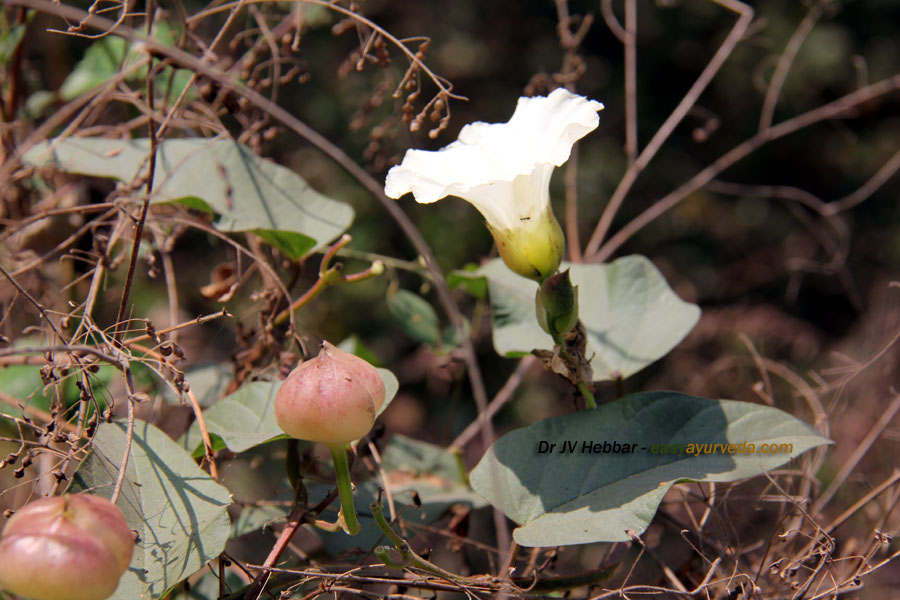
Table of Contents
Vernacular names
English Name- India Jalap, Saint Thomas Lidpod, Trasparent wood rose, Turpeth root
Hindi Name- Nisoth – निशोथ, Panila – पनिला, Pithori – पिठोरी
Telugu Name- Tegade – తెగడ
Bengali Name- Tevudi – त॓वूडी
Marathi Name- Nisottar, Nishottar,
Gujarathi Name- Nasttara
Tamil Name- Sivadai, Adimbu – சரளம், kumpncan, paganrai
Malayalam Name- Chivaka
Kannada Name- Vilitigada, aluthi gida, bangada balli, bilitigade, devadanti, nagadanti
Home remedies
Trivrit Remedies:
Abdominal distension, constipation
Fine powder in abdominal distension and constipation:
Shweta trivrit is made into fine powder and taken in the dose of 250-750 mg along with a cup of warm milk or lukewarm water. In case of severe constipation associated with hemorrhoids, decoction of raisins (dry grapes) is used as after drink along with this powder.
This relieves abdominal distension, burping and constipation.
General method of preparation of decoction (kashaya) – 1 tablespoon of powder is added with 2 cups of water, boiled and reduced to 1 cup, filtered.
Abdominal disorders, skin diseases
The roots cooked with cow’s milk for chronic abdominal disorders and skin diseases:
The shweta trivrit root is cleaned well or washed with water and then cooked with milk. This is taken in the dose of 20-30 ml in adults and 5-10 ml dose in children. This is effective in chronic abdominal pain, eczema, and allergic dermatitis.
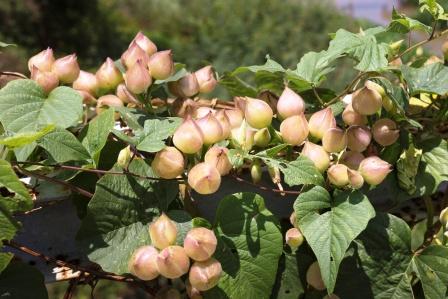
Abdominal pain, distension
Fine powder of Shweta trivrit, Triphala, Ajwain and Rock salt in abdominal pain, distension of abdomen and constipation:
The drugs Shweta trivrit, Triphala (Three myrobalans), Ajwain and Rock salt are taken in equal amounts and fine powder is made. This is taken in the dose of 3-5 grams along with buttermilk in case of IBS, hemorrhoids etc. Lukewarm water or jeerakarishtha is used as after drink (vehicle) for abdominal pain, distension of abdomen and constipation.
Skin diseases
Dilute decoction of Shweta trivrit in oozing and scaling skin diseases:
5 grams of trivrit is cooked with 200 ml water and reduced to 50 ml. This decoction is taken in cases like oozing and scaling skin diseases.
Abscess, ulcers
Fine paste of Trivrit and turmeric for abscess and ulcers:
Fine paste made out of turmeric and trivrit is applied in chronic oozing skin diseases (Tankana bhasma can also be used). This application is very useful in chronic ulcers and wounds.
Ayurveda believes that all diseases are results of indigestion or reduced digestive fire. Due to this toxins are increased in the body, mainly in the intestine. So, in all diseased conditions removal of the toxins is the priority and the drugs like Trivrit, Aragwadha (Cassia fistula), Draksha (Raisins) will safeguard the body and channels by expelling out the toxins from their main site of manifestation.
Click to consult Dr MS Krishnamurthy MD(Ayu), PhD
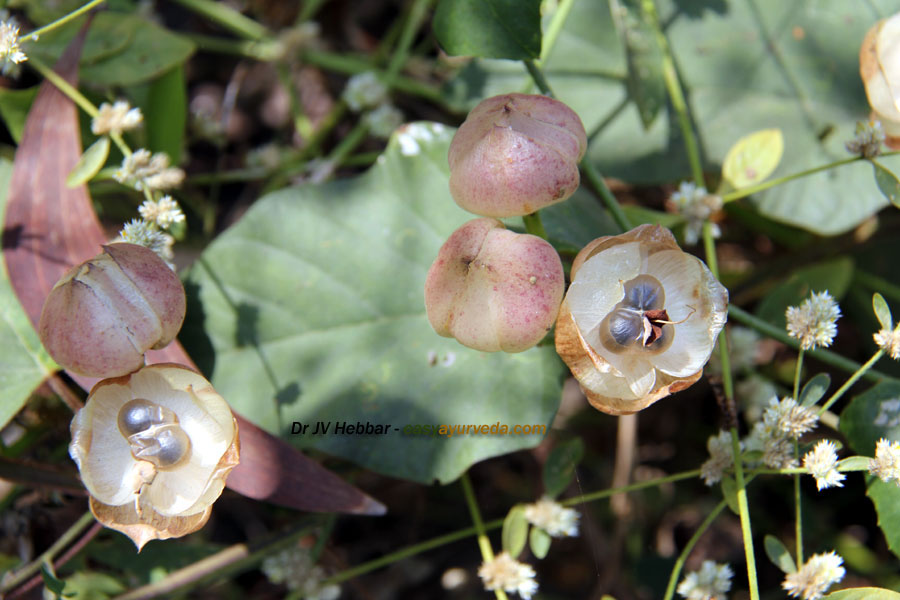
Photo credit – Dr.S.N.Murthy. Asst.Director ,I/C, NRIBAS,Kothrud, Pune
Medicinal properties
Operculina turpethum – medicinal properties
Rasa (Taste) – Bitter – Titka, Pungent – Katu
Guna (qualities)- lightness – Laghu, Dryness – Rooksha, Strong, piercing – Teekshna
Vipaka- Katu – undergoes pungent taste conversion after digestion.
Veerya- Ushna – hot potency
Effect on Tridosha – Balances Pitta and Kapha. It increases Vata Dosha.
Prabhava – Special effect – Rechana – causes purgation.
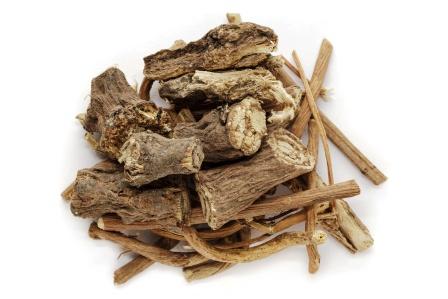
Part used, Dosage
Part Used- root bark, Leaves
Trivrit Dosage- Powder 1-3 grams in a divided dose per day.
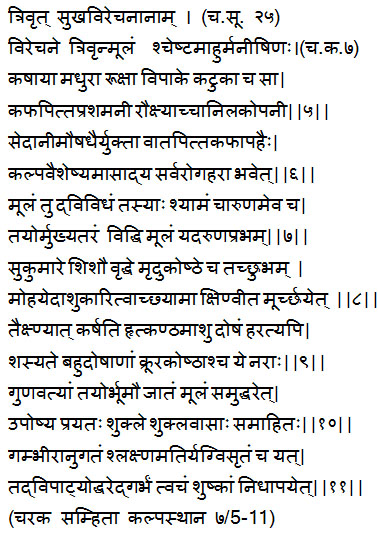
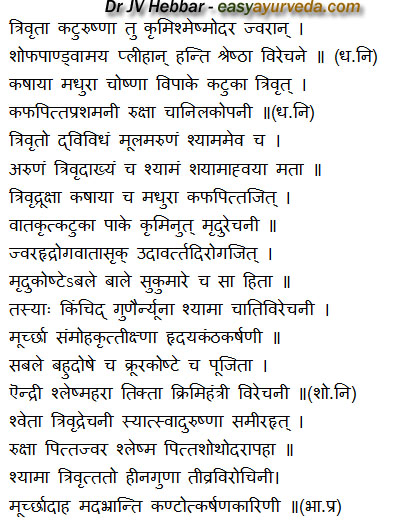
Therapeutic uses
Of all the herbs useful in easy purgation, Operculina turpethum is the best.
Because of its strong, pungent and piercing nature, it helps in losing weight.
It is useful to relieve constipation
Krumihara – useful in worm infestation, infected wounds
Shleshmodara – useful in ascites
Jvaraghna – useful in fever
Shophahara – useful in inflammation
Panduhara – useful in anemia, early stage of liver disorders
Pleeha – Disease of the spleen, Splenomegaly
Hrudroga – useful in heart disorders,
Vatasruk – useful in gout,
Udavartahara – relieves bloating, gas distension in abdomen
In hemorrhoid treatment, it is administered along with Triphala Churna
Anti-ulcer activity
Morphology, standardization
Efficacy against paracetamol induced liver toxicity
Analgesic activity
Side effects
Trivrit side effects –
Operculina turpethum root, if used excessively, or if used in people with low strength, it causes burning sensation, dizziness, twitching pain of abdomen and sever purgation.
Hence, in most of Ayurveda formulations, its root bark only is used in place of root.
To avoid its side effect, it is usually used in combination with ginger, dill seeds, rock salt or sugar candy.
It is best avoided during pregnancy and lactation.
It should be used in minimal dosage of 125 – 250 mg in children.
Interaction with medicines, supplements
Can this be used while taking Homeopathic medicine?
Yes. This product does not react with homeopathic medicine.
Can this medicine be continued while taking supplements like multivitamin tablets, Omega 3 fatty acids etc?
Yes. Generally, this product goes well with most dietary supplements. However, if you are taking more than one product per day, please consult your doctor for an opinion.
With western medicines
Seek your doctor’s advice if you are taking this product along with other western (allopathic / modern) medicines. Some Ayurvedic herbs can interact with modern medicine.
If both Ayurvedic and allopathic medicines are advised together, then it is best to take Allopathic medicine first, wait for 30 minutes and then take the Ayurvedic medicine.
Ayurvedic medicines
Ayurvedic medicines with Trivrit ingredient –
Krimighatini Bati – useful in intestinal worm infestation
Abhayarishta – useful in hemorrhoids, constipation
Chandraprabha Vati – useful in skin and liver disorders
Kankayana Vati – useful in piles, fistula, sinuses.
Miscellaneous uses
Miscellaneous uses of Trivrut:
In case of skin diseases where the skin lesions are numb and absolutely anesthetic, if there is absence of sweating and itching, then they are rubbed with the brush made of stem of Trivrut so as to initiate bleeding. This is described as a method of bloodletting therapy to treat skin diseases. Reference: Charaka Chikitsasthana 7/56
Trivrit for Virechana
Milk boiled with Trivrit and castor seeds(eranda) is used in the treatment of ascites due to Pitta imbalance (Charaka Samhita Chikitsa Sthana, 13th chapter).
Trivrit for hemorrhoids
Trivrit (Operculina turpethum) along with Triphala churna for oral intake, is said to be a remedy for hemorrhoids. (Charaka Chikitsa Sthana 14th chapter)
Sanskrit Synonyms
Tribhandi, Triputa, Trivrit- Stem is triangular in shape
Sarala, Suvaha, Rechani – causes purgation
Ardhachandra, Kumuda Gandhini.
nisodha – Useful in oedema
Tyasra – Stem has 3 angles
Classical Categorization
Charaka – Bhedaniya – herbs that have piercing and purgation action
Sushruta- Shyamadi,
Adhobhagahara – groups of herbs useful in Virechana.
Vagbhata- Syamadi
Bh P Ni – Guduchyadi varga
Varieties, Distribution
Trivrit (Nisoth) is of two kinds viz; Shyama (black) and Shukla or Aruna( white / red)
The white variety is identified as Murva – Marsdenia tenacissima
Bh Pr ni – Swetha and Syama
Ra. Ni – Trivrit and Rakta Trivrit
Distribution
It is commonly found on the roadsides across India, upto 1000 square feet.
Major Chemical Constituents
a and B- Turpethins, Scopoletin, Turpethinic acids A, Turpethin, Scopoletin, coumarin. etc (Reference: Illustrated Dravyaguna VIjnana, Vol. II, by Dr JLN Shastry)
The root contains active constituents by name A-turpethin and B-turpethin. Considerable amount of lignin and ferrous oxide is also present in this herb.
Another variety of the plant is Krishna/ Shyama trivrit is considered to be more purgative and should be used with more precautions.
The roots are sweet mixed bitter in taste, hot in potency and dry in nature.
The plant is Kaphapittahara and pacifies the oedema and abdominal disorders.
Morphology
Habit-Perennial twiner with milky juice.
Root- Long, slender, fleshy, branched
Stem- Very long twining and twisted together, angled and winged, pubescent, tough
Leaves-Simple, ovate or oblong
Petiole is 2 to 5 cm long.
Inflorescence- Few flowered cyme
Flower- stout, pubescent, slightly thickened upwards. Corolla is white, sub campanulate.
Fruit- Capsule, globose, enclosed in enlarged brittle imbricate sepals.
Useful part: Root- Root is stout, cylindrical 1 to 3 cm diameter surface is reddish brown in color, having longitudinal furrows. Internally the root shows a thick bark and a central woody portion which is twisted The cortex is loaded with a resin of pale yellowish color. On breaking it becomes short at bark portion and fibrous in the central woody part.
Sthanika Karma (Systemic Action)
Digestive System – Purgative medicine. indicated in abdominal distension, abdominal cramp, constipation, jaundice, hemorrhoids, Rheumatic joint diseases, etc.
In case of hemorrhoids its root can be given with triphala decoction
Circulatory System – Indicated in generalized edema.
Tapakrama – Indicated in Fever (Root powder along with honey)
Satmikarana – Having scraping action on dhatus











7 comments
Sadik
So does Trivrit help a person to lose weight ONLY by causing purgation (i.e. loose motions), or is there some other mechanism?
Dr Sadik (Allopathic physician)
Dr J V Hebbar MD(Ayu)Author
Dear Dr Sadik, Apart from being a purgative, Trivrit also has Hepato-protective action (research articles –
http://www.ncbi.nlm.nih.gov/pubmed/19589336
http://www.ijpsonline.com/article.asp?issn=0250-474X;year=2006;volume=68;issue=1;spage=32;epage=35;aulast=Suresh)
In Ayurvedic terms, it helps in Pitta Rechana (expulsion of unhealthy Pitta out of body).
Pitta balancing leads to Medo Dhatu Agni correction (correction of fat metabolism), leading to weight loss.
To make it further easy,
As per Ayurveda, in obesity, Medo dhatu agni is imbalanced, leading to excess conversion of food nutrients into fat tissue, leading to depletion of digestive fire, causing Ama (a complex altered digestion and metabolism complex).
Trivrit helps to break this complex and leads to correction of Agni (digestion and metabolism process).
shubham patil
sir you should know that it does the rechana karama it is not limited only to that of virechana you have to know about guna and karma chapter based on rechana karm it does the aapatarpana wich causes the weight loss
sujaya
Is trivrit powder available in ayurvedic shops..??
shan
planet ayurveda.com
Navneet Bagga
Trivit also known as Nisoth operculine terpethum root is an ingredient of many Ayurvedic Medicines CONSTIEASE by DrG Wellness contains 7.08%.
ACHINTYA KUMAR SETT
Sir,
I am having a garden where recently I have kept the plant Trivrit or Operculina turpethum.
Unfortunately I am unaware of how to care for it &
The plant is dying.
It would be great if you can suggest how the plant can be grown, watering, fertilizer & sunlight requirements.
Thanks in advance.
Best regards,